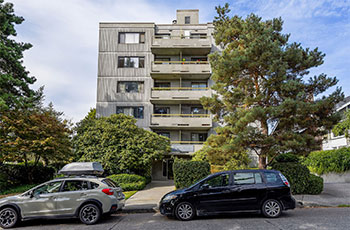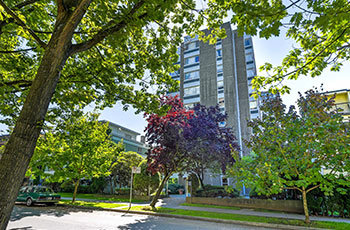
Summary
Vancouver housing provider Brightside wanted to do its part for climate action by creating a strategy to make its buildings net zero. By evaluating its current emissions and setting reduction targets, it was able to create a strategy that is ambitious yet actionable. Now, it’s moving forward on retrofitting its buildings to make them more energy efficient and less reliant on fossil fuels.
Background

Brightside Community Homes Foundation, a non-profit with 26 buildings and nearly 1,000 homes in Vancouver, has a 70-year history and almost $250 million in assets. This positions them to lead in transitioning to net zero, offering insights for smaller entities. In 2021, motivated to combat climate change, Brightside planned a net zero strategy. After board approval, they strategized their approach. Located in British Columbia, where hydroelectric power is predominant, Brightside has found that transitioning from fossil fuels to electricity can drastically cut its emissions.
"If we’re going to be upgrading a building’s windows in five years, how do we use that as an opportunity to electrify and make it as close as possible to net zero?" – William Azaroff, CEO, Brightside
The challenge
Brightside believed in the mission of making their portfolio of buildings net zero, both in terms of taking climate action and of improving their housing offering. The question was, how could they create a plan with concrete steps to take and an ambitious yet realistic timeline?
Approach
Brightside was already collaborating with Affine Climate Solutions on another project and decided to continue working with them on developing a net zero strategy. The process included:
- Creating an emissions inventory
- Setting emissions targets
- Researching net zero strategies by other organizations
- Building out a plan for Brightside
Brightside’s main emissions are from building operations, so the plan emphasizes retrofits like window replacements and adoption of electric systems such as heat pumps. Other sources, like vendors and transportation, contribute less to their carbon footprint. In 2022, two pilot projects with heat pumps and new windows provided key insights. Brightside is targeting net zero by 2035, believing it’s a faster approach than initially aiming for 2040.
Barriers
As is typical for a non-profit, Brightside has limited cash flow and depends in part on outside funding. This can make it challenging to plan for big projects. Maintaining the strategy as a “living document” allows them to be nimble and adaptable. The strategy is updated as they complete and learn from various individual projects.
Results

Following the board’s approval, the team explained the plan to all staff, aiming to generate enthusiasm and support.
The plan lays out clear steps and goals for cutting down Brightside’s carbon emissions. For example, to meet its target of zero emissions by 2035, the plan involves upgrading about two buildings every year.
Benefits
In addition to the emissions-reduction benefits of the net zero strategy, many individual projects will improve residents’ comfort and the buildings’ climate resiliency. For example, the transition to heat pumps means that many units will have their first-ever access to home cooling, a technology that has become essential to Vancouverites as the climate warms. This transition is also likely to lower utility bills for those residents who pay them.
In the spirit of knowledge-sharing, Brightside is also making its strategy freely available to other housing providers who might want to use it as a blueprint for their own net zero strategy.
Lessons learned
Speed is of the essence when it comes to reducing emissions, and to that end, Brightside and Affine took an 80/20 approach to the emissions inventory, which they say paid off in getting them started as quickly as possible. Rather than trying to reach perfection when assessing the organization’s carbon footprint, they aimed to get to 80 percent accuracy, which is enough data to move forward on action without getting bogged down in details.
In this vein, they decided to start by focusing on reducing the emissions they directly cause, like those from their own buildings and cars (scope 1), as well as emissions from the energy they buy, like electricity and heating (scope 2). After making progress in these areas, they'll then look at reducing emissions from their broader network, like those linked to the products and services their suppliers provide (scope 3). This step-by-step approach helps them make immediate changes where they have the most control.
Developing the strategy was streamlined by Brightside's prior use of Energy Star Portfolio Manager, a tool that helps track and manage data on building usage and utilities. This software simplifies the gathering and examination of data, which is crucial for analysis and strategy planning. Brightside recommends that adopting a portfolio management system is a vital step for organizations aiming for net zero emissions. Such a system is instrumental in effectively tracking progress toward environmental targets. Peer learning was also a valuable tool in creating the strategy. Brightside reached out to other organizations who had done similar work that they could build on and learn from. Finally, Brightside recommends finding a good, experienced consultant to partner with to develop a strategy. They worked with Affine, a local organization, but there are other resources across the country too.
Next steps

Following approval of its net zero strategy, Brightside has been working to get specific projects off the ground. For instance, two six-storey buildings in East Vancouver are being redeveloped to Passive House standards thanks to funding from GMF and the Government of Canada. They will provide 157 housing units for low-income seniors and people with mobility challenges and are on track to be completed by spring 2024.
The team is also moving forward on refining the strategy, including assessing and reducing scope three emissions.
Get started
To follow in Brightside's footsteps, begin by examining their strategy, which draws on insights from organizations with similar experiences. FCM’s capacity development resources can be a useful tool here, including the Community of Practice for sustainable affordable housing funded retrofit projects and the GMF project database.
Reach out to GMF-funded Regional Energy Coaches (RECs), who offer free one-on-one coaching and support to affordable housing providers of any size with projects at any stage. RECs can find opportunities for energy efficiency, assess project feasibility, support funding applications and share information about the types of technologies that can be leveraged.
The Sustainable Affordable Housing initiative, delivered through the Green Municipal Fund, supports affordable housing providers in improving their energy efficiency. This is achieved through funding and capacity development support for energy-efficient retrofits and new builds. Visit our website for more information, including how to access a Regional Energy Coach.
Want to explore all GMF-funded projects? Check out the Projects Database for a complete overview of funded projects and get inspired by municipalities of all sizes, across Canada.

